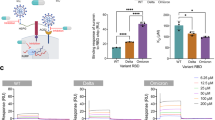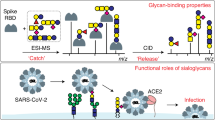Abstract
Dengue virus is a human pathogen that has reemerged as an increasingly important public health threat. We found that the cellular receptor utilized by dengue envelope protein to bind to target cells is a highly sulfated type of heparan sulfate. Heparin, highly sulfated heparan sulfate, and the polysulfonate pharmaceutical Suramin effectively prevented dengue virus infection of target cells, indicating that the envelope protein-target cell receptor interaction is a critical determinant of infectivity. The dengue envelope protein sequence includes two putative glycosaminoglycan-binding motifs at the carboxy terminus; the first could be structurally modeled and formed an unusual extended binding surface of basic amino acids. Similar motifs were also identified in the envelope proteins of other flaviviridae. Developing pharmaceuticals that inhibit target cell binding may be an effective strategy for treating flavivirus infections.
This is a preview of subscription content, access via your institution
Access options
Subscribe to this journal
Receive 12 print issues and online access
$209.00 per year
only $17.42 per issue
Buy this article
- Purchase on Springer Link
- Instant access to full article PDF
Prices may be subject to local taxes which are calculated during checkout
Similar content being viewed by others
References
Henchal, E.A. & Putnak, J.R. The dengue viruses. Clin. Microbiol. Rev. 3, 376–396 (1990).
Institute of Medicine (U.S.), Committee on Emerging Microbial Threats to Health. Emerging Infections: Microbial Threats to Health in the United States (National Academy Press, Washington, DC, 1992).
Halstead, S.B. The XXth century dengue pandemic: Need for surveillance and research. World Health Stat. Q. 45, 292–298 (1992).
Monath, T.P. Dengue: The risk to developed and developing countries. Proc. Natl. Acad. Sci. USA 91, 2395–2400 (1994).
World Health Organization. Dengue and dengue hemorrhagic fever. Report N117. (World Health Organization, Geneva, 1996).
Centers for Disease Control. Dengue Fever at the U.S.–Mexico Border, 1995–1996. Morbid. Mortal. Weekly Rep. 45, N39 (1996).
Tyler, K.L. & Fields, B.N. Pathogenesis of viral infections. in Fields Virology, 3rd edn., Vol. 1. (eds. Fields, B.N., Knipe, D.M. & Howley, P.M.) 173–217 (Lippincott-Raven, Philadelphia, 1996).
Wimmer, E. in Cellular Receptors for Animal Viruses. (ed. Wimmer, E.) 1–13 (Cold Spring Harbor Laboratory Press, Cold Spring Harbor, NY, 1994).
Porterfield, J.S. Antibody-dependent enhancement of viral infectivity. Adv. Virus. Res. 31, 335–355 (1986).
He, R.-T. et al. Antibodies that block virus attachment to Vero cells are a major component of the human neutralizing antibody response against dengue virus type 2. J. Med. Virol. 45, 451–461 (1995).
Rice, C.M. Flaviviridae: The viruses and their replication. in Fields Virology, 3rd edn., Vol. 1. (eds. Fields, B.N., Knipe, D.M. & Howley, P.M.) 931–959 (Lippincott-Raven, Philadelphia, 1996).
Chen, Y., Maguire, T. & Marks, R.M. Demonstration of binding of dengue virus envelope protein to target cells. J. Virol. 70, 8765–8772 (1996).
Couchman, J.R. & Woods, A. Structure and biology of pericellular proteoglycans. in Cell Structure and Extracellular Glycoconjugates, Vol. 1. (eds. Roberts, D.D. & Mecham, R.P.) 33–82 (Academic Press, New York, 1993).
Rostand, K.S. & Esko, J.D. Microbial adherence and invasion through proteoglycans. Infect. Immun. 65, 1–8 (1997).
Thompson, L.D., Pantoliano, M.W. & Springer, B.A. Energetic characterization of the basic fibroblast growth factor–heparin interaction: Identification of the heparin binding domain. Biochemistry 33, 3831–3840 (1994).
Fromm, J.R., Hileman, R.E., Caldwell, E.E., Weiler, J.M. & Linhardt, R.J. Differences in the interaction of heparin with arginine and lysine and the importance of these basic amino acids in the binding of heparin to acidic fibroblast growth factor. Arch. Biochem. Biophys. 323, 279–287 (1995).
Bernfield, M. et al. Biology of syndecans. Annu. Rev. Cell Biol. 8, 365–393 (1992).
Toida, T., Imanari, T., Hileman, R.E., Fromm, J.R. & Linhardt, R.J. Structural differences in heparan sulfates from different tissues and species. Biochem. J. 322, 499–506 (1997).
Linhardt, R.J. & Toida, T. Heparin oligosaccharides-new analogs development and application. in Carbohydrates as Drugs (eds. Witczak, Z.B. & Nieforth, K.A.) 277–341 (Marcel Dekker, New York, 1997).
Pervin, A., Callo, C., Jandik, K.A., Han, X.J. & Linhardt, R.J. Preparation and structural characterization of large heparin-derived oligosaccharides. Glycobiology 5, 83–95 (1995).
Toida, T., Hileman, R.E., Smith, A.E., Vlahova, P.I. & Linhardt, R.J. Enzymatic preparation of heparin oligosaccharides containing antithrombin III binding sites. J. Biol. Chem. 271, 32040–32047 (1996).
Linhardt, R.J. Analysis of glycoconjugates. in Current Protocols in Molecular Biology, Vol. 2. (ed. Varki, A.) 17.13.17–17.13.32 (Wiley Interscience, Boston, 1994).
Bame, K.J. & Esko, J.D. Undersulfated heparan sulfate in a Chinese hamster ovary cell mutant defective in heparan sulfate N-sulfotransferase. J. Biol. Chem. 264, 8059–8065 (1989).
Esko, J.D. et al. Inhibition of chondroitin and heparan sulfate biosynthesis in Chinese hamster ovary cell mutants defective in galactosyltransferase I. J. Biol. Chem. 262, 12189–12195 (1987).
Lidholt, K. et al. A single mutation affects both N-acetylglucosaminyltransferaseand glucuronosyltransferase activities in a Chinese hamster ovary cell mutant defective in heparan sulfate biosynthesis. Proc. Notl. Acad. Sci. USA 89, 2267–2271 (1992).
Esko, J.D., Stewart, T.E. & Taylor, W.H. Animal cell mutants defective in glycosaminoglycan biosynthesis. Proc. Natl. Acad. Sci. USA 82, 3197–3201 (1985).
Baeuerle, P.A. & Huttner, W.B. Chlorate–a potent inhibitor of protein sulfation in intact cells. Biochem. Biophys. Res. Commun. 141, 870–877 (1986).
Raake, W., Klauser, R.J., Elling, H. & Meinetsberger, E. Anticoagulant and an-tithrombotic properties of synthetic sulfated bis-lactobionic acid amides. Thromb. Res. 56, 719–730 (1989).
Sternbergh, W.C., Sobel, M. & Makhoul, R.G. Heparinoids with low anticoagulant potency attenuate postischemic endothelial cell dysfunction. J. Vasc. Surg. 21, 477–483 (1995).
Mohan, P., Hopfinger, A.J. & Baba, M. Naphthalenedisulfonic acid derivatives as potential anti-HIV agents: Chemistry, biology and molecular modeling of their inhibition of reverse transcriptase. Antiviral Chem. Chemother. 2, 215–222 (1991).
Cardin, A.D. & Weintraub, H.J. Molecular modeling of protein-glycosaminoglycan interactions. Arteriosclerosis 9, 21–32 (1989).
Faham, S., Hileman, R.E., Fromm, J.R., Linhardt, R.J. & Rees, D.C. Heparin structure and interactions with basic fibroblast growth factor. Science 271, 1116–1120 (1996).
Chen, W.-B. & Maguire, T. Nucleotide sequence of the envelope glycoprotein gene of a dengue-2 virus isolated during an epidemic of benign dengue fever in Tonga in 1974. Nucleic Acids Res. 18, 5889 (1990).
Rey, F.A., Heinz, F.X., Mandl, C., Kunz, C. & Harrison, S.C. The envelope glycoprotein from tick-borne encephalitis virus at 2 A resolution. Nature 375, 291–298 (1995).
Peitsch, M.C. ProMod and Swiss-Model: Internet-based tools for automated comparative protein modelling. Biochem. Soc. Trans. 24, 274–279 (1996).
Bork, P., Holm, L. & Sander, C. The immunoglobulin fold. Structural classification sequence patterns and common core. J. Mol. Biol. 242, 309–320 (1994).
McClain, D.S. & Fuller, O. Cell-specific kinetics and efficiency of herpes simplex virus type 1 entry are determined by two distinct phases of attachment. Virology 198, 690–702. (1994).
Montgomery, R.I., Warner, M.S., Lum, B.J. & Spear, P. Herpes simplex virus-1 entry into cells mediated by a novel member of the TNF/NCF receptor family. Cell 87, 427–436 (1996).
Maccarana, M., Sakura, Y., Tawada, A., Yoshida, K. & Lindahl;, U. Domain structure of heparan sulfates from bovine organs. J. Biol. Chem. 271, 17804–17810 (1996).
Jackson, T. et al. Efficient infection of cells in culture by type O foot-and-mouth disease virus requires binding to cell surface heparan sulfate. J. Virol. 70, 5282–5287 (1996).
Ortega-Barria, E. & Pereira, M.E. A novel T.cruzi heparin-binding protein promotes fibroblast adhesion and penetration of engineered bacteria and trypanosomes into mammalian cells. Cell 67, 411–421 (1991).
Ruoslahti, E. & Pierschbacher, M.D. New perspectives in cell adhesion: RGD and integrins. Science 238, 491–497 (1987).
Sanchez, I.J. & Ruiz, B.H. A single nucleotide change in the E protein of dengue virus 2 Mexican strain affects neurovirulence in mice. J. Gen. Virol. 77, 2541–2545 (1996).
Lin, B., Parrish, C.R., Murray, J.M. & Wright, P.J. Localization of a neutralization epi-tope on the envelope protein of dengue virus type 2. Virology 202, 885–890 (1994).
Jiang, W.R., Lowe, A., Higgs, S., Reid, H. & Gould, E.A. Single amino acid codon changes detected in louping ill virus antibody-resistant mutants with reduced neurovirulence. J. Gen. Virol. 74, 931–935 (1993).
Jennings, A.D. et al. Analysis of a yellow fever virus isolated from a fatal case of vaccine-associated human encephalitis. J. Infect. Dis. 169, 512–518 (1994).
Holzmann, H., Heinz, F.X., Mandl, C.W., Guirakhoo, F. & Kunz, C. A single amino acid substitution in envelope protein E of tick-borne encephalitis virus leads to attenuation in the mouse model. J. Virol. 64, 5156–5159 (1990).
Cecilia, D. & Gould, E.A. Nucleotide changes responsible for loss of neuroinvasive-ness in Japanese encephalitis virus neutralization-resistant mice. Virology 181, 70–77 (1991).
Reed, L.J. & Muench, H. A simple method of estimating fifty per cent end points. Am. J. Hygiene 27, 493–497. (1938).
Ojala, W.H. et al. Complexes of lysine, histidine and arginine with sulfonated azo dyes: Model systems for understanding the biomolecular recognition of glycosaminoglycans by proteins. J. Am. Chem. Soc. 118, 2131–2142 (1996).
Author information
Authors and Affiliations
Rights and permissions
About this article
Cite this article
Chen, Y., Maguire, T., Hileman, R. et al. Dengue virus infectivity depends on envelope protein binding to target cell heparan sulfate. Nat Med 3, 866–871 (1997). https://doi.org/10.1038/nm0897-866
Received:
Accepted:
Issue Date:
DOI: https://doi.org/10.1038/nm0897-866
This article is cited by
-
Electrochemical capacitive dengue aptasensor using NS1 in undiluted human serum
Microchimica Acta (2024)
-
Pathway analysis of host responses to dengue virus serotype 2 infection and inhibition of viral envelope protein by naringenin from Ganoderma lucidum
Journal of Biosciences (2023)
-
Humoral immune response induced with dengue virus-like particles serotypes 1 and 4 produced in silkworm
AMB Express (2022)
-
Dengue virus co-opts innate type 2 pathways to escape early control of viral replication
Communications Biology (2022)
-
Studies on the antiviral activity of chebulinic acid against dengue and chikungunya viruses and in silico investigation of its mechanism of inhibition
Scientific Reports (2022)



